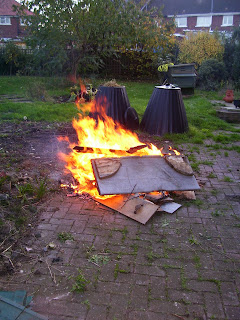Bonfire time at Maison Cosgrove-Bray. Going up in flames was a 1940s chest of drawers, the type which is more wood than drawer space - an ugly old thing well beyond its usefulness or re-sale value. There was also a heap of autumn pruning - branches, bits of hedge, snapped bamboo canes, broken brush handles etc. Oh, and two kitchen rugs which were remarkable only for their vileness.
In the midground of the photo are two compost bins made from recycled rubber. The cone-like sides lift up cleanly if a garden fork is levered beneath them; they don't have a base. These bins have been in constant use for ten years and show absolutely no sign of wear. Beyond the compost bins is the green-coloured chicken coup.
The photo shows only half of our rear garden, which is also the side which we've done the least with so far. The garden is now ready for a good tidy-up before winter sets in. Brick flooring can a mixed blessing, as every tiny groovy between each brick becomes a home for weeds, and the floor by the compost bins is a mess due to leaves falling off the branches I'd pruned.
The ash from the bonfire, once cool, will be shovelled around our rhubarb.



Comments